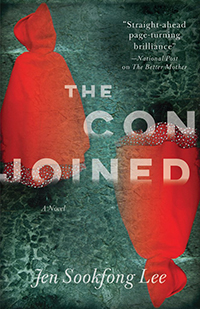Reviews
Fiction Review by Phoebe Wang
Jen Sookfong Lee, The Conjoined (Toronto: ECW, 2016). Paperbound, 264 pp., $18.95.
 There are novels in which readers can wrap themselves in a cozy haze of escapism, but Jen Sookfong Lee’s The Conjoined is not one of them. Lee’s approach to crime fiction prompts me to wonder why thrillers are pleasurable. If they are a form of escapism, then what kinds of harsh realities are we evading, and if readers take voyeuristic enjoyment in grisly murders and criminal behaviour, then what is missing from our mundane daily routines?
There are novels in which readers can wrap themselves in a cozy haze of escapism, but Jen Sookfong Lee’s The Conjoined is not one of them. Lee’s approach to crime fiction prompts me to wonder why thrillers are pleasurable. If they are a form of escapism, then what kinds of harsh realities are we evading, and if readers take voyeuristic enjoyment in grisly murders and criminal behaviour, then what is missing from our mundane daily routines?
Jessica Campbell, the protagonist of Lee’s novel, seems in need of an escape when we first encounter her. Her career as a social worker in Vancouver has brought her from one support agency to another, yet despite the “noble pursuit” of finding foster families for abused and neglected children, Jessica is dogged by a sense of futility and stagnancy: “The number of files she couldn’t satisfactorily close grew. It didn’t matter how many times she moved them, the pile sat—top-heavy and teetering—in her head. She could never shake them. And she was scared of failing, always failing.”
Here is a woman at a crisis point in her life: disillusioned by the system she is working within, weary of her boyfriend and his “mental system of privilege and risks and best practices,” and numbed by the recent death of her mother, Donna, who was “not a saint, but close.” While sorting through the detritus of her mother’s useful life, Jessica makes a discovery that undoes her presumptions about goodness and what it costs. Finding the bodies of two teenage sisters, Casey and Jamie Cheng, in a freezer in her mother’s basement becomes the catalyst for Jessica’s plunge into traumatic, subsumed memories.
Jessica’s discoveries are interspersed with episodes depicting Casey and Jamie before they are briefly in foster care with Jessica’s mother, as well as Donna’s childhood. Jessica picks apart past events, painfully confronting truths that both haunt her and compel her to search further. The plot races forward with each revelation, and then slows as Jessica reels with its consequences. The reader also experiences a similar tension between craving to know more details, and aversion and horror at each disclosure. This tension is inherent in our pleasure at reading thrillers, but in The Conjoined, the events feel too close to home to be salacious or entertaining. At times, certain plot turns can feel too convenient and scripted, yet they serve to highlight how complicity can envelop individuals and communities in a fog of guilt, forgetfulness, silence, and complacency. Jessica learns how certain questions will unravel the careful façade of an easy life. That façade is propped up by photo albums of family memories: “this was the version of her family Donna wanted to remember: happy, craftsy, nature-loving,” and beneath it is a legacy of violence that goes unpunished. While questions may lead to the truth unfolding, they do not bring justice, at least not in the Vancouver depicted in Lee’s story. The Conjoined could be a portrait of Vancouver’s social tensions arising from race and class divisions. With very few exceptions, social workers, housing officers, foster parents, and police officers are middle-class and white, while foster children and disappeared women are of colour and from lower-income backgrounds. Asking after the disappeared reveals that there are lives that matter and lives that don’t: “What difference does it make? Except that there were two girls, twenty-eight years later, whose deaths should have made a difference and didn’t.”
Creating a protagonist such as Jessica Campbell allows Lee to flesh out in unflinching and sometimes droll ways the hamartia of privilege. Jessica slowly realizes that for most of her life she was insulated from tragedy, only brushing up against it in the files of children awaiting adoption or in her blurred awareness of the girls’ movements beyond her bedroom door at night. Despite Jessica’s capacity for growth and self-reflection, I often felt exasperated by her conflicting desires, which is perhaps the point. If the reader feels an unnamed frustration towards the three generations represented by Jessica, Donna, and Grandma Beth, perhaps it’s because we recognize in them our own capacity for gentle hypocrisy.
I would have liked to spend more time with the Cheng family, who are too busy merely surviving to be improving the lives of others. Bill, Ginny, Jamie, and Casey are blown apart in a way that feels predictable, perhaps because there were too many familiar elements to this part of the story: the father who spends days drinking through the family’s savings after being laid off; a mother working multiple jobs and fearful for her daughters when they venture beyond Chinatown; the rebellious, restless girls; and Wayne, the older, male friend of their father’s whose desire is both a threat and a possible escape. While these characters’ lives pound on the page like an aching pulse, their fates feel inevitable. They don’t have the luxury of reflecting on the tragedies that pursue them and, as a result, a sense of helplessness immures the Cheng family in spite of their plans for the future. It isn’t enjoyable to watch characters flailing, yet we can’t turn away. Perhaps this is because the irresolution of their misfortune might hold some insight into how we cope with our own thwarted plans and catastrophes. If one person’s escape is another’s adversity, The Conjoined implies that we can no longer avert our eyes.
—Phoebe Wang









